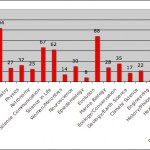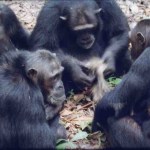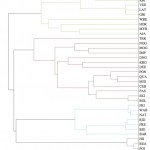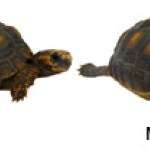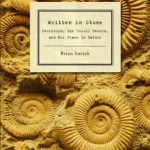
On Wednesday I posted the full list of the almost 900 posts submitted to Open Lab. As part of the process that I'm using to distribute the posts to my awesome reviewers, I've assigned each post a primary category. (Clearly, many of the posts can easily fit into more than one category, but based on the post, the blog's general content - as far as I know or can tell - or whatever other information is available to me, I've picked one to be primary.)
Here's the breakdown of the posts by category (click to enlarge):
table.tableizer-table {border: 1px solid #CCC; font-family: Verdana, Verdana,…
"Two chimps had been shut out of their shelter by mistake during a cold rain storm. They were standing dejeted, water streaming down their shivering bodies, when Professor Köhler chanced to pass." Upon opening the door for the two chimps, Dr. James Leuba recounts, "instead of scampering in without more ado, as many a child would have done, each of them delayed entering the warm shelter long enough to throw its arms around his benefactor in a frenzy of satisfaction."
"Chimpanzees," primatologist Frans de Waal points out, "do not normally hug their caretakers for no reason." It's a compelling…
And it is over! The submission deadline has just passed. No more submissions will be accepted for the 2010 edition of the Open Laboratory.
I have lined up an impressive list of reviewers who will immediately start receiving their first judging lists and the complex process of winnowing down almost 900 entries into the final 50 essays/stories, one poem, one piece of art (for the cover) and one cartoon/comic strip. As usual, the book will be published with lulu.com and we'll try to have the book ready roughly in time for ScienceOnline2011 (we always say that, I know, but this time we'll really…
An awesome video from our friends over at BBC Earth Life Is:
We caught up with Richard Sorger, a hot British fashion designer who draws inspiration directly from animals and nature. As well as designing for big name celebrities his work he has also designed for Swarovski and the Victoria & Albert Museum in London.
Here are my Research Blogging Editor's Selections for this week:
Ready for some more Thanksgiving science? Brad Walters of Cortical Hemming and Hawing asks what football can tell us about decision-making: Why you should always go for it on 4th and short.
The Neurocritic reports a fascinating study of a woman who had epileptic seizures triggered by eating. Or, more specifically, eating strawberry syrup.
And the award for lede of the week goes to Christian Jarrett of BPS Research Digest, who writes, "Announcing that neuroscience writer Jonah Lehrer had been listed as one of Salon's sexiest…
A fun talk about sex, death and evolution at LA's Natural History Museum. It's free and ticketless -- so please bring friends and colleagues!
WHEN: Thursday, December 2, 6-7:30pm.
WHERE: LA Natural History Museum in the Times Mirror Room.
WHAT: Australian paleontologist John A. Long is the recently appointed vice president of research and collections at the Natural History Museum of Los Angeles County. Long has been actively engaged in research on the early evolution of fish and dinosaurs. In 2001 Dr. Long won the Eureka Prize for the Public Promotion of Science.
This is how Caltech…
There are only FIVE DAYS left for submissions! Dig through your archives, through other people's archives and submit!
Note: if you have recently moved your blog, please e-mail Bora the corrected URLs for your entries
The list is growing fast - check the submissions to date and get inspired to submit something of your own - an essay, a poem, a cartoon or original art.
The Submission form is here so you can get started. Under the fold are entries so far - almost 700 of them, with more coming in each day.
The instructions for submitting are here.
You can buy the last four annual collections…
Ah, Thanksgiving. A day full of turkey, cranberries, pie, and, of course, SCIENCE! After you fill your stomach with gravy and stuffing, stuff your mind with all this great Thanksgiving science.
What's any good Thanksgiving feast without some turkey? Emily Anthes of Wonderland starts the meal off with an offering of thanks for the turkey's contribution to cancer research. But wait! That's not all the science of turkeyhood to be consumed. Feast your minds on my contribution at the Scientific American Guest Blog: the social-cognitive abilities of turkeys. And in case you're feeling particularly…
Even still, we tend to think of the turkey as a fairly unintelligent bird, skilled at little more than waddling around, emitting the occasional "gobble," and frying up golden-brown-and-delicious. But...what if I told you that the domestic turkey (Meleagris gallopavo) could actually be quite clever, at least when it comes to social cognition? Apocryphal or not, Ben Franklin may have been on to something with the "Bird of Courage."
Head on over to Scientific American to catch my latest contribution to their Guest Blog: Turkey talk: The social cognition of your Thanksgiving dinner
Buchwalder, T…
Here are my Research Blogging Editor's Selections for this week:
Sleep is really important for health and cognition among other things. But what about for memory? An interesting discussion at Psychothalamus about the relationship between sleep and remembering to remember.
A fascinating post at Wiring the Brain begins with pain sensitivity in fruit flies and ends with synaesthetic mice! It's a bit of a wild ride, but well worth the read.
Finally, at the Neuroskeptic blog, enjoy a post entertaining the speculation that Samson (of biblical fame) may have been autistic. Speculative, indeed.
One…
In one of a series of stories on animal intelligence, Anderson Cooper went to see Kanzi, probably the most famous bonobo in the world, and primatologist Sue Savage-Rumbaugh, who has worked with Kanzi almost his entire life. Using his board of symbolic "lexigrams," Kanzi apparently indicated that Cooper should don a bunny suit. One wonders whether the producers asked Savage-Rumbaugh to selectively interpret Kanzi's intentions in that way, and how much footage wound up on the cutting room floor. In any case, its actually pretty funny.
Nearly one-third of the world's amphibian species are at risk of extinction. The rescue project aims to save more than 20 species of frogs in Panama, one of the world's last strongholds for amphibian biodiversity. While the global amphibian crisis is the result of habitat loss, climate change and pollution, chytridiomycosis is likely at least partly responsible for the disappearances of 94 of the 120 frog species thought to have gone extinct since 1980.
Read more about the Panamanian Amphibian Rescue and Conservation Project, and check out their blog, here.
(h/t Smithsonian Institution)
Scientists thought they had a pretty good handle on the social interactions of bottlenose dophins (Tursiops). They've used the term fission-fusion dynamics to describe dolphin (and non-human primate) society and so far it has served researchers well. Fission-fusion societies among dolphins are characterized by two levels of social hierarchy: groups of two or three related males ("first-order alliances") which work together to guard one or more females from other males, and larger teams comprised of multiple related first-order alliances ("second-order alliances") which cooperate to "steal"…
You may have noticed that I've stopped doing linkfests. I decided that the time put in to their curation (i.e. the 'cost') outweighs the value of doing so (i.e. the 'benefit'). It also occurred to me that most of the things I would curate in my weekly linkfests were the same items I tweeted throughout the week, and many of the same items I share in Google Reader.
So, for those of you who enjoyed the linkfests or want to keep your eyes on interesting things to read on the web, I encourage you to follow me on twitter, or if you *just* want the links without the rest of the twitter shenanigans,…
This amazingly clear 3D ultrasound image of an elephant fetus was taken just three months into its 22-month-long gestation period. The little guy, now named George, was born nineteen months later at ZSL's Whipsnade Zoo.
You can even see his little trunk and everything!
(h/t Metro UK)
Here are my Research Blogging Editor's Selections for this week:
According to the Neurocritic, "Most everything you've read about the Doctors Prescribing 'Tetris Therapy' study is wrong." Find out why.
What happens when a fish sees its own reflection? If you're like most people, you'd say that he fish treats the reflection as if it were another fish. But Zen Faulkes of Neurodojo explains why you might be wrong.
John Brock of the blog 'Cracking the Enigma' wonders if one of the so-called "autism genes" is more specifically involved with neural connectivity. He writes, "Having this gene doesn'…
Thanks to everyone who participated in this year's Donors Choose Science Bloggers for Students campaign. Twenty-two readers from this humble blog donated a total of $524, affecting a total of 904 students! And that's not all, because HP is matching every dollar donated, so your $524 is actually worth $1048.
Keep your eyes on your email inboxes for the emails from Donors Choose with information on how to use the HP-matched vouchers to help even more students - don't ignore those emails, or those matching funds will go UNUSED!
Overall, the support from the science-blog-reading community has…
Have you ever been at a party with lots of people chatting away, when for some unexplainable reason you felt compelled to turn and look at the front door of your friend's house...and just as you were looking, someone was just coming in from outside and closing the door? You couldn't have heard the door open since there was so much noise already inside - more likely you noticed that other people were looking at the front door. All of this probably happened without any explicit intention or awareness. If several others are all directing their attention at a specific point in space, there might…
Only twenty days left for submissions! Dig through your archives, through other people's archives and submit! I've already started to contact potential judges for this year's anthology. We're ready to roll!
Note: if you have recently moved your blog, please e-mail Bora the corrected URLs for your entries
The list is growing fast - check the submissions to date and get inspired to submit something of your own - an essay, a poem, a cartoon or original art.
The Submission form is here so you can get started. Under the fold are entries so far. The instructions for submitting are here.
You can buy…
This week marked the release of Brian Switek's (blog, twitter) first book, Written in Stone. I got my hands on a review copy a few weeks ago, and I have nothing but good things to say about it. (Disclaimer: I was provided with a free review copy of the book, without any expectation that I'd review it on my blog or elsewhere.)
Written in Stone is a highly-accessible, engaging book which takes the reader simultaneously through the story of vertebrate evolution and the story of the scientists who - quite literally - uncovered it. The book's main success might be in its seamless transition back…
